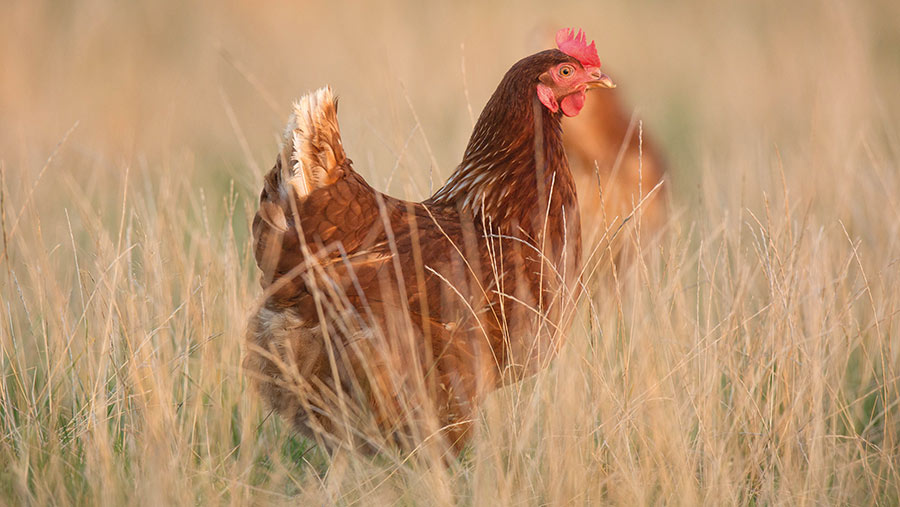12 ways poultry farmers can tackle net zero
 © Tim Scrivener
© Tim Scrivener Changes to diets, improvements in genetics and health, and rethinking the use of manure and poultry litter all have potential to reduce greenhouse gas (GHG) emissions.
GHG emissions in the poultry sector come largely as a result of feed production, with the manufacture, handling and transportation of feed equating to about 70% of the sector’s carbon footprint, according to UK National Inventory data.
There is clear scope to improve this figure, but which mitigation strategies have the greatest potential, and how do their costs compare?
See also: 9 steps to cutting carbon emissions on poultry farms
Emissions reduction
Research into a number of carbon-cutting solutions was carried out by a group of scientists for The Centre of Innovation and Excellence in Livestock (Ciel), headed by Professor Elizabeth Magowan from the Agri-Food and Biosciences Institute.
The study showed genetic improvement could be a low-cost way of reducing nitrous oxide emissions and would also be very easy to implement now.
By contrast, using poultry litter as a fuel instead of fertiliser would be a difficult, high-cost strategy, although it could also bring further advantages such as the reduction of odours and ammonia emissions.
Results focused on three key areas: the animal itself, feed and fertiliser (see below).
Expert view Tom Gill, head of sustainability at Promar
Feed is a key focus area for reducing poultry emissions, with many strategies applicable to both broilers and layers, says Tom Gill, head of sustainability at Promar.
Mr Gill co-authored a recent report for the British Free Range Egg Producers Association (Bfrepa), the first phase of which looked specifically at net zero and environmental sustainability.
He offers some advice on adapting feed strategies to encompass the net-zero goal.
Use of alternative ingredients
The big focus here is on soya, and I think there is going to be a growth in expectation over the next three years for producers to significantly reduce their emissions from feed.
Traditionally, much of the protein in poultry diets has come from soya sources.
However, it comes at a very large carbon cost, with emissions estimated between 9kg and 15kg CO2e/kg [carbon dioxide equivalent a kilogram] for soya.
Getting to a place where alternative products are routinely used in the diet, without affecting bird health or welfare, might not be quite attainable yet, but there is progress being made to look at new solutions.
This includes the use of rapemeal, sunflower meal, lupins, triticale and even insect protein, which could substitute some of the soya.
There is also ongoing work looking at how certain cover crops can be harvested and the seed heat-treated to become a high-impact protein source.
However, the effectiveness and the effect on bird welfare is mixed.
For example, there is evidence to show that getting the protein source wrong can lead to more infighting within the flock, which then impacts meat or egg production.
In theory, using alternative protein sources has the potential to make a huge difference on the carbon footprint front, but it is important to ensure they stack up economically too.
It is also not clear legislatively when some of these alternatives may become an option.
In the report produced for Bfrepa, initial estimations – based on feed formulation using modelling of IPCC emissions data – for replacing soya with alternative sources indicated a potential reduction in emissions of 60%.
Precision feeding and management
While implementing precision feeding and management might not be possible yet, the key first step for producers is working with feed companies and nutritionists to start scoping what this may look like.
Prior to adopting any automation or precision, it is important to ensure efficiency from a dietary perspective and balance the opportunity for including feeds such as amino acids and synthetics – as well as replacement protein sources for soya.
It is also really important to work through contract specifications to understand if there are any restrictions or expectations that may affect the ability to make changes.
That said, any automation that does come in is likely to require some capital investment, and with the challenges facing the sector at present, I am not sure there is an appetite for that quite yet.
So at the moment, I think the biggest opportunity to tackle emissions is through nutrition and the composition of the diet.
Poultry sector at a glance
This article takes as its starting point the Centre for Innovation Excellence in Livestock’s recent report Net Zero and Livestock: How Farmers Can Reduce Emissions, which provides a snapshot of the poultry sector:
- The UK poultry industry has benefited from huge growth, with the total value of poultrymeat and eggs totalling £3.5bn in 2020
- This is dominated by meat production, with the poultry sector responsible for about 13% of the UK’s gross agricultural output
- Specific challenges for poultry include nitrogen, ammonia and phosphorous emissions
- Feed production – processing and transport – is the main contributor to the poultry sector’s carbon footprint (for both egg and meat production), totalling about 70% of all emissions.
